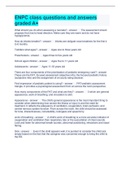Exam (elaborations)
ENPC class questions and answers graded A+
- Course
- Institution
ENPC class questions and answers graded A+ What should you do when assessing a neonate? The assessment should progress from toe to head direction. Make sure they are warm and do not have hypoglycemia. How do infants breathe? Infants are obligate nose breathers for the first 4 to 6 months....
[Show more]



